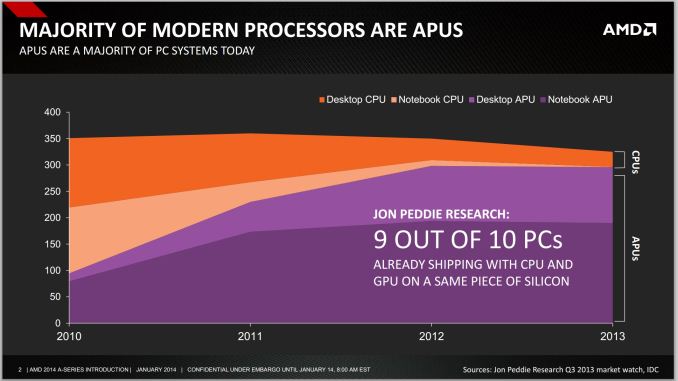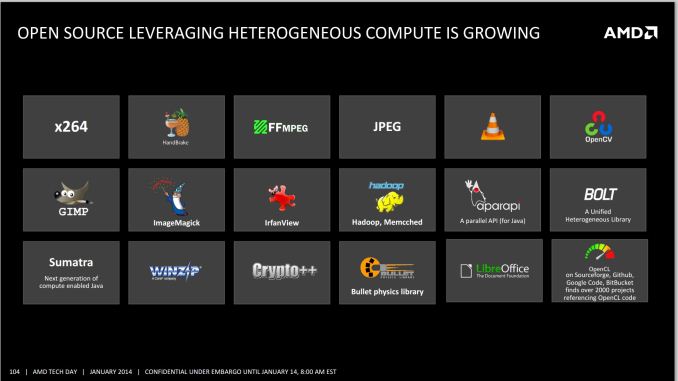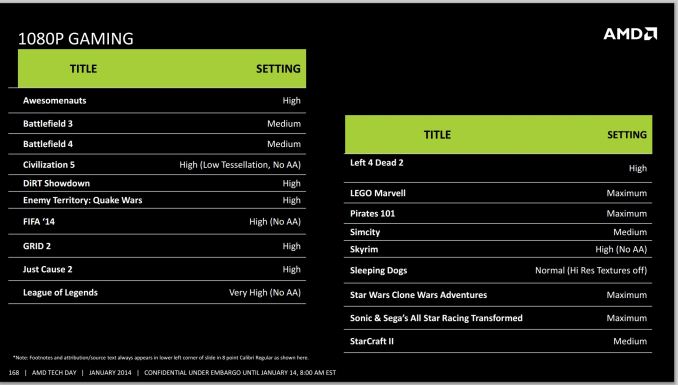AMD Kaveri Review: A8-7600 and A10-7850K Tested
by Ian Cutress & Rahul Garg on January 14, 2014 8:00 AM ESTKaveri: Aiming for 1080p30 and Compute
The numerical differences between Kaveri and Richland are easy enough to rattle off – later in the review we will be discussing these in depth – but at a high level AMD is aiming for a middle ground between the desktop model (CPU + discrete graphics) and Apple’s Mac Pro dream (offloading compute onto different discrete graphics cards) by doing the dream on a single processor. At AMD’s Kaveri tech day the following graph was thrown in front of journalists worldwide:
With Intel now on board, processor graphics is a big deal. You can argue whether or not AMD should continue to use the acronym APU instead of SoC, but the fact remains that it's tough to buy a CPU without an integrated GPU.
In the absence of vertical integration, software optimization always trails hardware availability. If you look at 2011 as the crossover year when APUs/SoCs took over the market, it's not much of a surprise that we haven't seen aggressive moves by software developers to truly leverage GPU compute. Part of the problem has been programming model, which AMD hopes to address with Kaveri and HSA. Kaveri enables a full heterogeneous unified memory architecture (hUMA), such that the integrated graphics topology can access the full breadth of memory that the CPU can, putting a 32GB enabled compute device into the hands of developers.
One of the complexities of compute is also time: getting the CPU and GPU to communicate to each other without HSA and hUMA requires an amount of overhead that is not trivial. For compute, this comes in the form of allowing the CPU and GPU to work on the same data set at the same time, effectively opening up all the compute to the same task without asynchronous calls to memory copies and expensive memory checks for coherency.
The issue AMD has with their HSA ecosystem is the need for developers to jump on board. The analogy oft cited is that on Day 1, iOS had very few apps, yet today has millions. Perhaps a small equivocation fallacy comes in here – Apple is able to manage their OS and system in its entirety, whereas AMD has to compete in the same space as non-HSA enabled products and lacks the control. Nevertheless, AMD is attempting to integrate programming tools for HSA (and OpenCL 2.0) as seamlessly as possible to all modern platforms via a HSA Instruction Layer (HSAIL). The goal is for programming languages like Java, C++ and C++ AMP, as well as common acceleration API libraries and toolkits to provide these features at little or no coding cost. This is something our resident compute guru Rahul will be looking at in further detail later on in the review.
On the gaming side, 30 FPS has been a goal for AMD’s integrated graphics solutions for a couple of generations now.
Arguably we could say that any game should be able to do 30 FPS if we turn down the settings far enough, but AMD has put at least one restriction on that: resolution. 1080p is a lofty goal to hold at 30 FPS with some of the more challenging titles of today. In our testing in this review, it was clear that users had a choice – start with a high resolution and turn the settings down, or keep the settings on medium-high and adjust the resolution. Games like BF4 and Crysis 3 are going to tax any graphics card, especially when additional DirectX 11 features come in to play (ambient occlusion, depth of field, global illumination, and bilateral filtering are some that AMD mention).













380 Comments
View All Comments
PolarisOrbit - Tuesday, January 14, 2014 - link
In the GPU benchmarks the charts were all divided into categories "Performance," "Quality," and "Xtreme." I went back to Testing Platform page to discern what these meant but it didn't say. Any clues?Ryan Smith - Tuesday, January 14, 2014 - link
Check the first page of the GPU performance section; it goes over the different categories.Th-z - Tuesday, January 14, 2014 - link
Nice review and very nice info from Rahul. Questions and comments:1. Not sure why you guys think this should be called SoC. Its MB still has a southbridge and other components to make a complete system.
2. Page 2, first paragraph: "Apple’s Mac Pro dream" and "by doing the dream on a single processor". What is the "dream" you are referring to?
3. Page 9, Table "Intel TestBed", i7s should be 4C/8T.
4. Don't you guys think it's odd that how close 95 W A10-7850K compares to 65 W A8-7600 and 45 W A8-7600 in gaming? With 33.3% more SP, it should have more noticeable increase in FPS. We see better spread with Richland, yet all three of Kaveri are so close to each other, which really makes 7850K unattractive with more than double the TDP compares to 7600 at 45 W.
Could it be it may have been bottlenecked by memroy bandwidth? Sooner or later AMD would need to do their own embedded RAM or putting GDDR5 on MB -- the world's first user configurable GDDR5 on MB, that would be something.
T1beriu - Tuesday, January 14, 2014 - link
4. Could it be because all of them have the same 512 core GPU clocked at the same speed of 720Mhz?T1beriu - Tuesday, January 14, 2014 - link
Nope, I'm just blind.ws3 - Tuesday, January 14, 2014 - link
The Iris Pro results have got to be very worrying for AMD.Yes, Intel is still behind in integrated graphics, but they are improving by leaps and bounds, and their CPU performance is miles ahead of AMD.
I loved my Athlons, but I think AMD is on the verge of having nothing to offer.
UtilityMax - Tuesday, January 14, 2014 - link
Iris Pro is basically a proof that Intel can respond to AMD if the APU market does take off. Right now Iris Pro graphics are too expensive, but they could eventually move it onto the same die shared with a lower end i3 CPU.thomascheng - Wednesday, January 15, 2014 - link
AMD already proven they can make a bigger core. Just look at the PS4 and Xbox One. I think while Intel can have the performance crown, only a small percentage will actually buy it.andrewaggb - Wednesday, January 15, 2014 - link
The shame is that AMD should have released an APU similiar to the Pro. They have the tech, the drivers, mantle coming, the gaming deals... to actually pull it off. The biggest problem with iris pro (besides price) is that intel drivers suck. AMD drivers (at least in single gpu scenerios) work well. I think releasing cheap apu's is a good move as well, but at least one high end model would have been good. I think it would sell reasonably well if it could get 60fps at 1080p (ps4 level perf). I don't even think it has to be all that cheap, should be worth at least $100 premium. It enables new possibilities and smaller/quiter form factors. People like that.khanov - Tuesday, January 14, 2014 - link
As you hinted at several times in your article, I think we could see even better iGPU performance from Kaveri with increasing memory bandwidth. I wonder if you might be interested in benchmarking some games at different memory frequency settings up to (and beyond?) DDR3-2400?I personally was hoping that Kaveri might launch with a quad-channel DDR3 memory controller. Yes it would require a new socket and the added signal routing complexity would push up board prices a bit. However, as FM2+ boards are so cheap, I don't see that as a big issue really.
You also asked if anyone would be interested in a XBox One/PS4 style APU with significantly more GPU cores. Well I would! But again, that memory bandwidth issue needs to be resolved.
Something like a six layer mini ITX board with 8GB of GDDR5 soldered underneath (where else would there be room to put it?) would be the brilliant if coupled with a PS4 style APU. It's a nice dream.
Thanks for the very in-depth review. It was a pleasure to read.